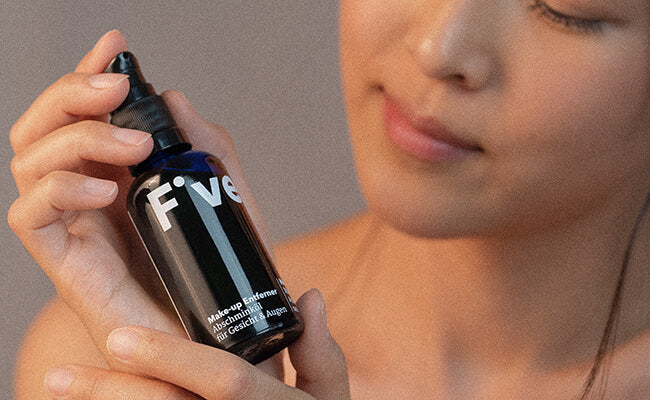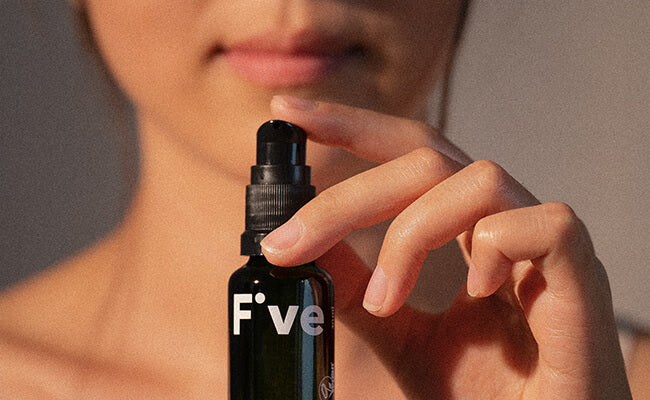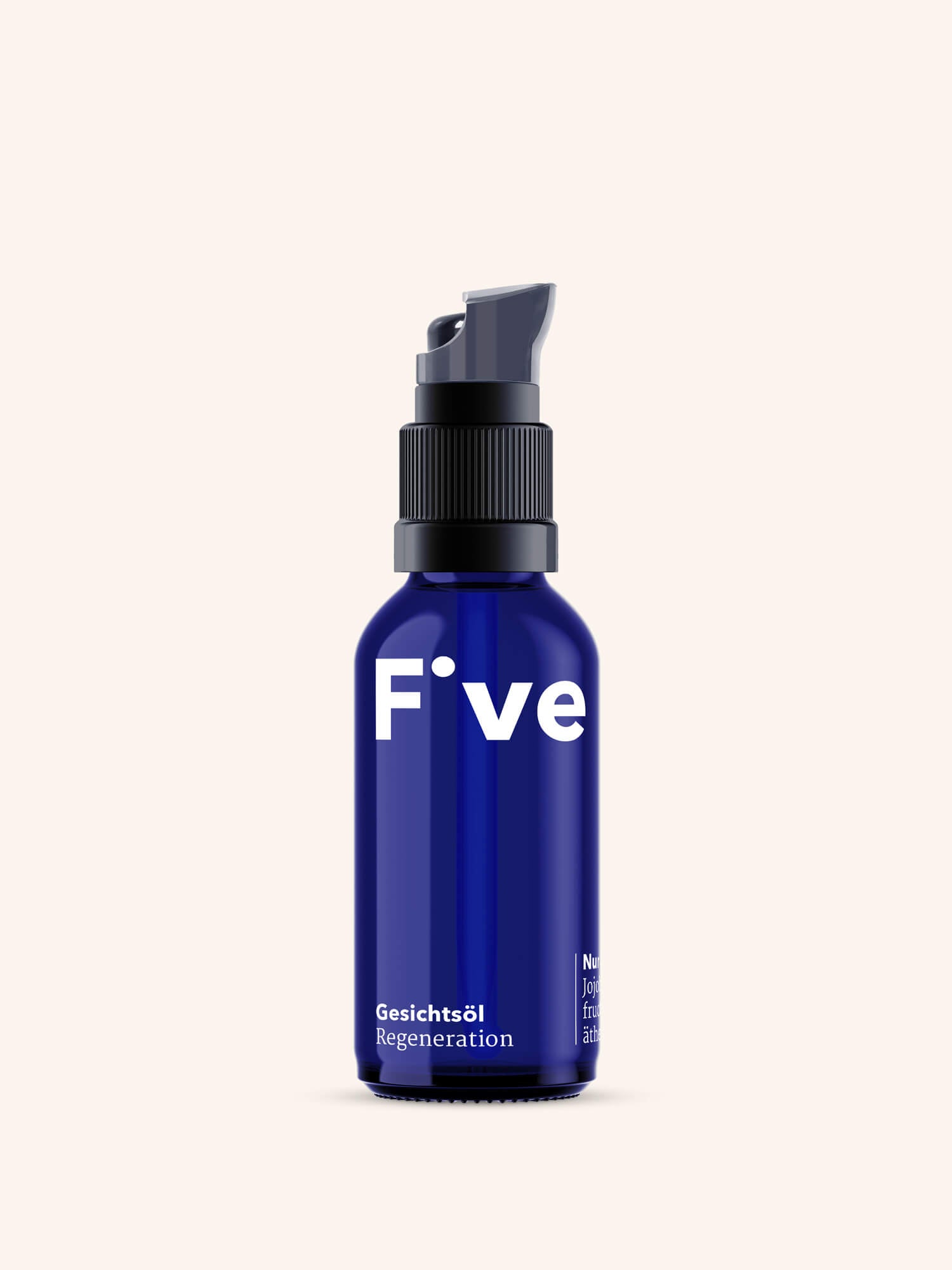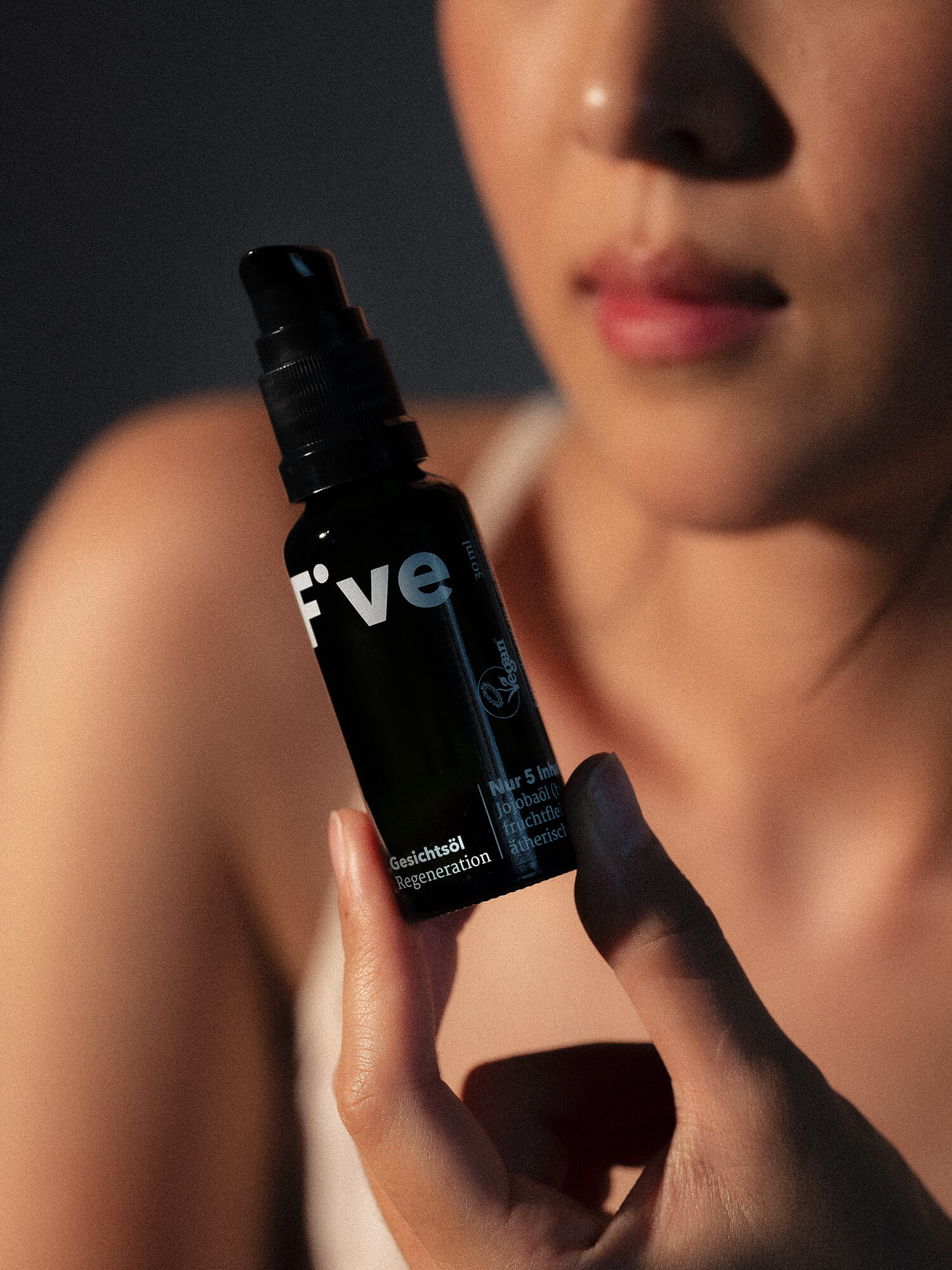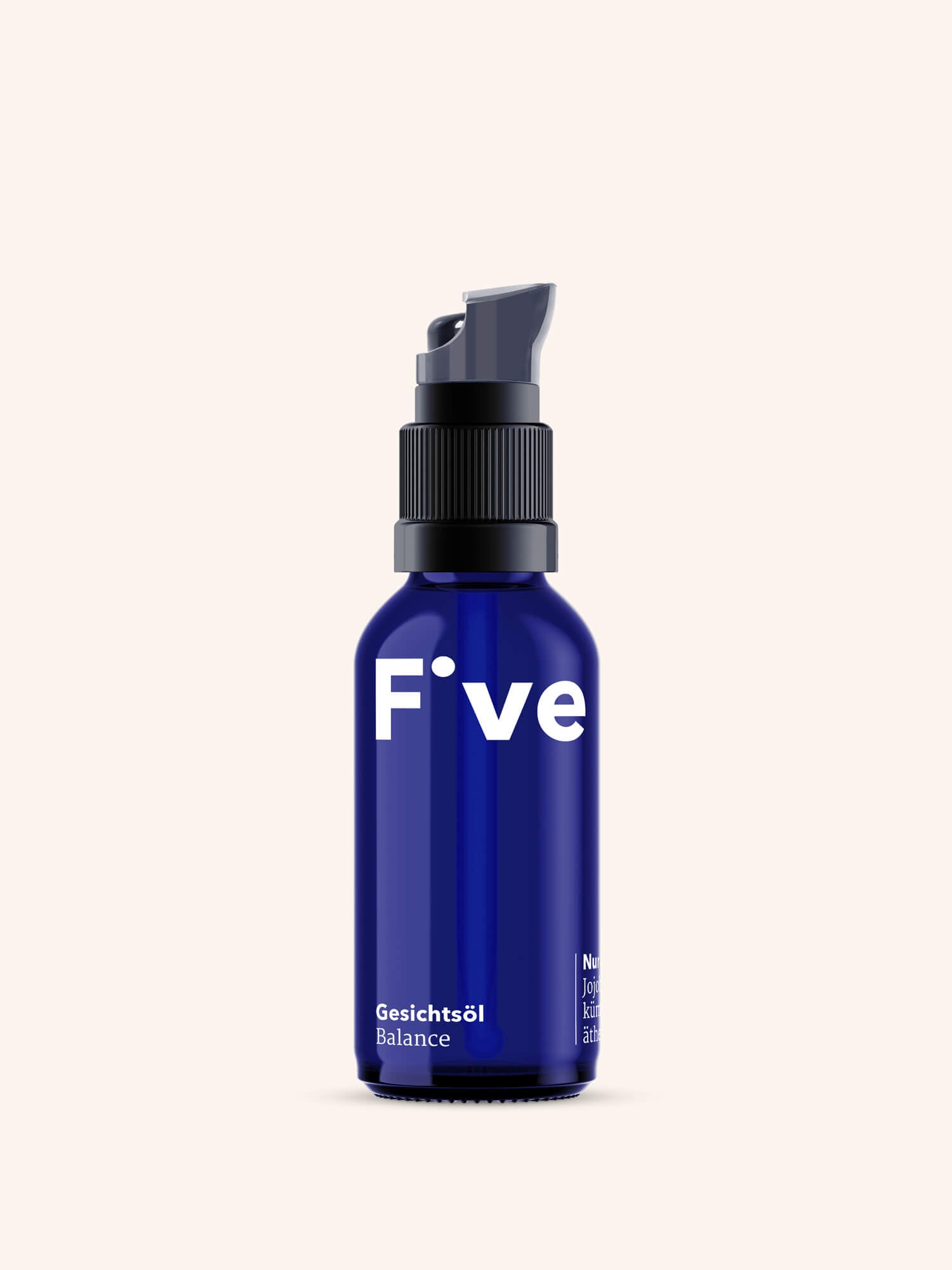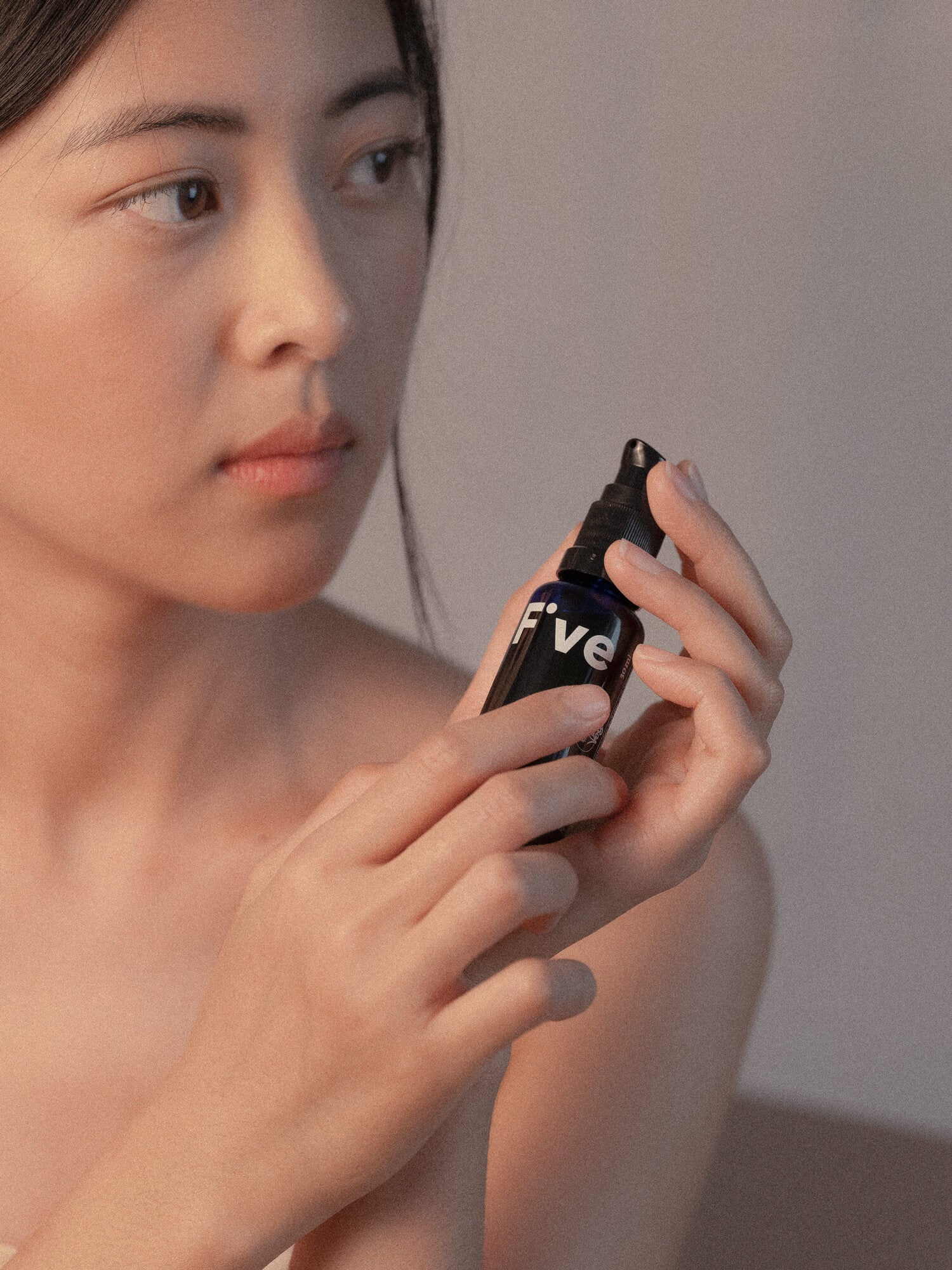Öle fürs Gesicht: Kann ich meine Haut nur mit Ölen pflegen?
Öle fürs Gesicht polarisieren – bei den einen gelten sie als magisches Beauty-Mittel für die tägliche Hautpflege, andere warnen vor ihren austrocknenden Eigenschaften. In diesem Artikel beginnen wir ganz von vorne: Wann ist die alleinige Ölpflege sinnvoll, welche Vorteile hat sie im Vergleich zu Cremes und welche Rolle spielen Lipide in der ganzen Geschichte? Plus: Du erfährst, wie du Öle fürs Gesicht richtig anwendest und welches Öl das beste für deinen Hauttyp ist.
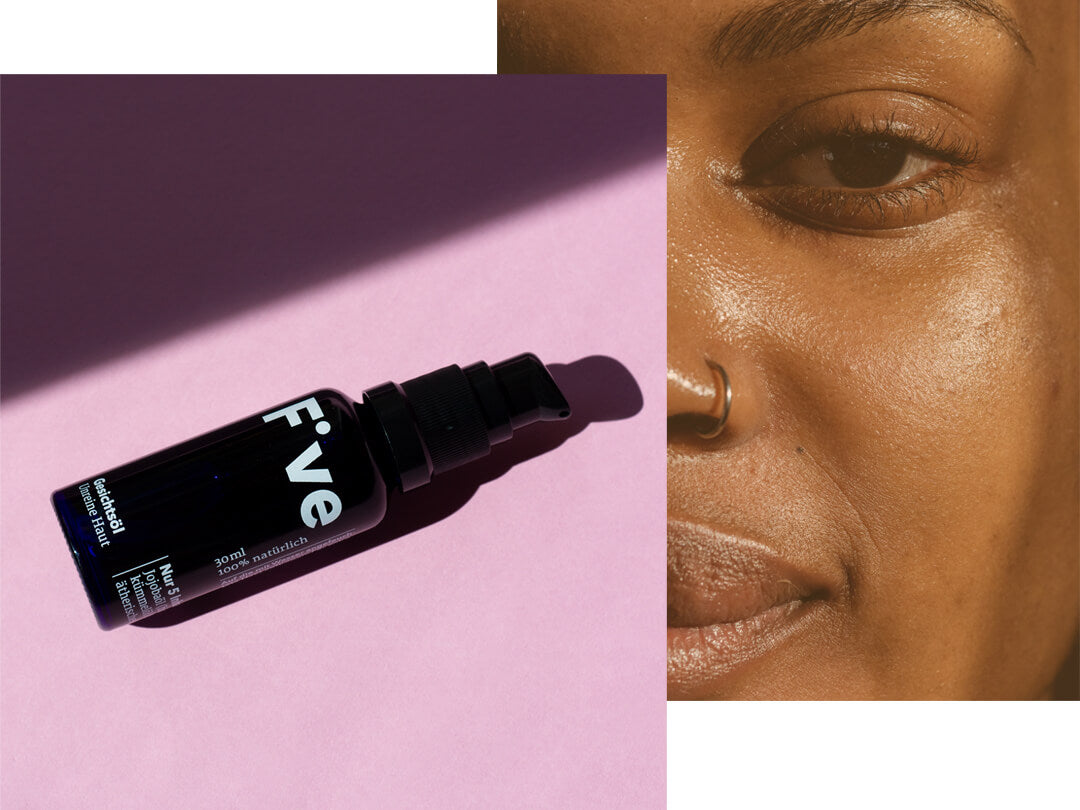
Foto von FIVE und Angela Roma
Reine Ölpflege vs. Creme: Welche Vorteile haben Öle fürs Gesicht?
Die reine Ölpflege hat zwei ganz entscheidende Vorteile gegenüber Cremes.
- Wenige Inhaltsstoffe und keine Füllstoffe, denn drin ist: Öl pur. Und wenn es sich statt um Mineralöl um natürliche Pflanzenöle handelt, profitiert deine Haut auch gleich von einer ganzen Fülle an Antioxidantien, Vitaminen und gesunden Fettsäuren.
- Frei von Emulgatoren und Konservierungsstoffen. Diese sind nämlich nur dann nötig, wenn eine Formulierung Wasser enthält. Ein reines Öl kann getrost darauf verzichten.
Das klingt doch schon mal gut, schließlich stehen wir alle auf minimalistische Hautpflege, oder? Die Antwort darauf hängt ganz davon ab, wen du fragst. Bestimmte Öle fürs Gesicht haben nämlich den Ruf, die Barrierefunktion zu stören und die Haut auszutrocknen. Dazu gehört etwa Olivenöl1. Um zu verstehen, was gute Öle für die Gesichtspflege ausmacht, gehen wir kurz einen Schritt zurück und widmen uns dem Aufbau unserer Haut.
Lipide, Feuchtigkeit und die Hautschutzbarriere – was du wissen solltest!
Unsere Oberhaut (die Epidermis) besteht aus mehreren übereinanderliegenden Schichten, von denen die Hornschicht (Stratum Corneum) als äußerste Schicht die Haut nach außen hin abschließt. Als direkte Grenze zur Umwelt erfüllt das Stratum Corneum eine wichtige Barrierefunktion, deren Bedeutung wir uns jetzt genauer ansehen.
- Schutzbarriere: Im Stratum Corneum befinden sich Hornfette (auch epidermale Lipide genannt), die die Zellen der Hornschicht zusammenhalten. Sie spielen eine Schlüsselrolle für unsere Hautgesundheit. Erstens binden sie Feuchtigkeit, zweitens bilden sie eine Schutzbarriere gegen äußere Einflüsse.
- Ziegelsteine & Mörtel: Stelle dir dieses Zusammenspiel vor, wie eine Mauer, die aus Ziegelsteinen (den Zellen der Hornschicht) und Mörtel (den epidermalen Lipiden) besteht. Gibt es zu wenig Lipide, wird die Mauer durchlässig: Feuchtigkeit kann leichter entweichen und die Haut reagiert empfindlicher auf Umwelteinflüsse. Die Folge: Trockenheit und Spannungsgefühle.
- Hydrolipidfilm & NMFs: Und noch mit einer weiteren Verteidigungslinie wartet unsere Haut auf: dem sogenannten Hydrolipidfilm. Er bedeckt die äußerste Hautschicht und wirkt als zusätzliche Barriere gegen schädliche Substanzen und Eindringlinge. Er enthält freie Fettsäuren aus den Talgdrüsen, Milchsäure und andere Sekrete aus dem Schweiß, sowie die NMFs – die natürlichen Feuchthaltefaktoren der Haut.
Öle fürs Gesicht: Warum es auf das Fettsäurespektrum ankommt!
Anders als etwa bei Vitamin C, wo es sich um einen einzelnen Stoff handelt, bestehen pflanzliche Öle aus einer ganzen Reihe von einzelnen Komponenten. Dieser Cocktail ist es, der über die Eignung eines bestimmten Öls für die Hautpflege entscheidet. Ein paar Beispiele gefällig?
Sanddornfruchtfleischöl:
gilt als eine der vielleicht kostbarsten pflanzlichen Substanzen der Welt2. Es enthält hohe Anteile der seltenen Palmitoleinsäure, die Bestandteil unserer hauteigenen Lipide ist. Diese auch als Omega-7 bekannte Fettsäure kurbelt die Hautregeneration an, unterstützt die Wundheilung und mindert das Erscheinungsbild von Narben und Pigmentflecken.
Und es geht noch besser: Palmitinsäure sorgt zusätzlich für weiche, geschmeidige Haut und verhindert übermäßigen Wasserverlust über die Hautoberfläche2. Weitere in Sanddornfruchtfleischöl enthaltene Beauty-Booster sind die Vitamine C und E, sowie Carotinoide (das Antioxidans gibt dem Öl die leuchtend orange Farbe) und Phospholipide (wichtig für die Zellerneuerung)3. Wir nutzen den Skin-Booster im FIVE Gesichtsöl für trockene Haut.
Schwarzkümmelöl:
zeichnet sich durch seinen hohen Gehalt an Linolsäure aus. Wie Palmitoleinsäure kommt auch sie natürlich in unserer Haut vor – Linolsäure ist die am häufigsten vorhandene ungesättigte Fettsäure unserer epidermalen Lipide4. Als Bestandteil der Ceramide (einer speziellen Form von Lipiden) und der natürlichen Feuchthaltefaktoren der Haut (der NMFs) unterstützt Linolsäure die Funktionen der Hautschutzbarriere und ist wichtig für einen strahlenden Teint. Deshalb ist das potente Öl die ideale Ergänzung für das FIVE Gesichtsöl Balance.
Das können Öle in der Gesichtspflege noch leisten!
In optimaler Zusammensetzung und richtig angewendet, sorgen Öle fürs Gesicht dafür, dass die Haut Feuchtigkeit besser halten kann, indem sie übermäßigen transepidermalen Wasserverlust verhindern. Aber aufgepasst: Öle spenden selbst keine Feuchtigkeit, sondern helfen der Haut nur dabei, Feuchtigkeit zu binden. Diesem Aspekt widme ich mich übrigens ausführlich in einem zweiten Artikel.
Hier jedoch schon mal so viel: Trägst du Öl auf die noch leicht feuchte Haut auf, wird diese Feuchtigkeit sozusagen eingeschlossen. Der Ölfilm schützt also vor Feuchtigkeitsverlust, indem er die Hautoberfläche versiegelt. Ein Prinzip, das sich viele Kulturen bereits vor Tausenden von Jahren zunutze machten – die Hautpflege mit Ölen gilt als eine der ältesten Formen der Körperpflege.
☝️ Fakt ist: Richtig angewandt, sind Öle fürs Gesicht phänomenale Beauty-Booster mit ganz individuellen Pflegeeigenschaften, von denen trockene bis unreine Haut profitieren können. Im FIVE Gesichtsöl für trockene Haut verwenden wir unter anderem Sanddornfruchtfleischöl, das regenerierend wirkt und antioxidative Eigenschaften hat. Das FIVE Gesichtsöl Balance enthält kostbares Schwarzkümmelöl und ätherisches Grapefruitöl, die mit ihrer antibakteriellen Wirkung punkten.
Wann sind Öle fürs Gesicht als alleinige Hautpflege sinnvoll?
Öle fürs Gesicht sind als alleinige Hautpflege dann ausreichend, wenn deine Haut über ausreichend Emulgatoren aus Eigenproduktion verfügt. Siehst du vor deinem inneren Auge gerade ein großes Fragezeichen auftauchen? Keine Sorge: Was das heißt, schlüsseln wir jetzt gemeinsam auf.
In gesunder Haut im Gleichgewicht erfüllen Fettsäuren, Cholesterin und Diglyceride die Funktion hauteigener Emulgatoren. Das bedeutet: Sie sorgen dafür, dass sich das Wasser aus Schweiß mit Lipiden auf der Hautoberfläche zu einem Gemisch verbindet. Die so entstehende Emulsion verteilt sich lückenlos auf der Haut, bindet hauteigene Feuchtigkeit und schützt vor übermäßigem Wasserverlust.
Eine Pflege, die Emulgatoren enthält, ist dann nicht notwendig – ein auf die feuchte Haut aufgetragenes, hochwertiges Gesichtsöl reicht aus. So nimmt die Hornschicht Feuchtigkeit auf und kann diese durch die versiegelnden Eigenschaften des Öls auch in der Haut halten.
Durstige Haut: In welchen Fällen die reine Ölpflege nicht ausreicht!
Verfügt deine Haut nicht über genug hauteigene Emulgatoren, kann die alleinige Pflege mit Öl deine Hautbedürfnisse nicht vollständig decken. Und auch feuchtigkeitsarmer Haut reichen Öle fürs Gesicht als Solo-Pflege nicht aus.
Je älter wir werden, desto mehr benötigt unsere Haut nicht nur rückfettende Lipide, sondern vor allem Feuchtigkeit. Die Haut braucht dann eine Pflege, die ihr Feuchtigkeit liefert und dabei hilft, diese auf und in der Haut zu binden. Öle auf die feuchte Haut aufzutragen, genügt in diesem Fall nicht mehr.
Mein Tipp: Mische einen Tropfen deines Gesichtsöls mit dem FIVE Gesichtsserum, das deine Haut nachhaltig mit Feuchtigkeit in Form von sanft duftendem Rosenwasser versorgt und diese durch feuchtigkeitsbindende Inhaltsstoffe wie Hyaluronsäure und Glycerin in der Haut hält.
Wie du Öle fürs Gesicht richtig anwendest!
Wir rekapitulieren: Als Faustregel gilt, Öle fürs Gesicht immer auf die noch leicht feuchte Haut aufzutragen. Der perfekte Zeitpunkt dafür ist nach der Dusche oder nach deinem täglichen Gesichtsreinigungsritual. Auf diese Weise kann das Öl die vorhandene Feuchtigkeit optimal in der Haut einschließen – und du darfst dich über einen gut durchfeuchtetes, seidig-weiches Hautbild freuen.
Eine Ausnahme gibt es allerdings: Für die Ölreinigung, z.B. mit dem FIVE Make-up Entferner mit mildem Jojobaöl, darf Gesichtsöl auf der trockenen Haut angewendet werden.
Ab etwa 25 Jahren (wenn die Feuchtigkeitsspeicherfähigkeiten der Haut langsam abnehmen) und bei trockener Haut verwöhnst du deine Haut am besten mit einer Kombination aus Gesichtsserum und Gesichtsöl. So unterstützt du die Wasserspeicherungsfähigkeiten deiner Haut mit nachhaltigen Feuchtigkeitsboostern wie Hyaluronsäure und nährst sie gleichzeitig mit wertvollen Lipiden.
Welches Öl für welchen Hauttyp?
Allrounder Jojobaöl: Es ist mit gutem Grund sowohl im FIVE Gesichtsöl Balance, als auch im FIVE Gesichtsöl für trockene Haut enthalten.
Seine lindernde, entzündungshemmende und beruhigende Wirkung macht es zu einem Multitalent für alle Hauttypen. Jojobaöl ist genau genommen ein flüssiges Wachs und ähnelt deshalb dem menschlichen Hauttalg, der sich ebenfalls zum Teil aus Wachs-Estern zusammensetzt5. Jojobaöl enthält essentielle Fettsäuren und antioxidativ wirkendes Vitamin E.
Diese Hauttypen profitieren besonders von Jojobaöl:
- trockene und reife Haut: Die niedrige Viskosität (= gute Fließfähigkeit) und das hohe Molekulargewicht von Jojobaöl sind für seine weichzeichnenden und hautschmeichelnden Eigenschaften bei trockener Haut verantwortlich. Das enthaltene antioxidativ wirkende Vitamin E schützt vor vorzeitiger Hautalterung durch oxidativen Stress.
- schlaffe, fahle Haut: Jojobaöl wirkt anregend auf die hauteigene Kollagenproduktion und sorgt für Elastizität und Spannkraft
- unreine und fettige Haut: Seine Ähnlichkeit zum menschlichen Hauttalg macht Jojobaöl zu einem besonders gut geeigneten Pflegeöl gegen Akne und Unreinheiten. Es wirkt klärend, indem es das überschüssige Sebum in den Poren auflöst und abtransportiert.
Schwarzkümmelöl bei unreiner Haut: Das Öl aus den Kernen der Nigella sativa gilt als Geheimtipp gegen Akne und Unreinheiten. Seine antibakteriellen und entzündungshemmenden Eigenschaften sorgten innerhalb einer wissenschaftlichen Studie für einen signifikanten Rückgang von Papeln und Pusteln bei Akne-Patienten6. Wir verwenden es im FIVE Gesichtsöl Balance.
Sanddornfruchtfleischöl als potentes Slow-Aging-Öl: Das Öl aus dem Fruchtfleisch der Sanddornbeere im FIVE Gesichtsöl für trockene Haut enthalten. Mit gutem Grund: Es ist ziemlich einzigartig, weil es besonders große Anteile der Omega-7-Fettsäure Palmitolein enthält7. Und die hat unserer Haut einiges zu bieten.
Das kann Sanddornöl für deine Haut tun:
- ebenmäßiger, aufgehellter Teint. Palmitoleinsäure kann das Erscheinungsbild von Pigmentflecken verringern6. Sie hemmt das Enyzm Tyrosinase, das für die Melaninbildung (das ist der Farbstoff unserer Haut und Haare) zuständig ist8.
- reines Hautbild: Palmitoleinsäure wirkt außerdem antimikrobiell, unterstützt die Wundheilung und sorgt so für gut geschützte, makellose Haut.
Squalan als ultimativer Weichzeichner: Squalan ist ein natürlicher Bestandteil unseres Hautfetts, das wir für die FIVE Skincare pflanzlich aus Oliven gewinnen. Wir verwenden es in beiden FIVE Gesichtsölen, denn dieses seidig-weiche Öl schmeichelt jeder Haut.
Das kann Squalan9:
- sorgt für ein geschmeidiges Hautgefühl
- ist hochverträglich, da es auch natürlich in der Haut vorkommt
- zieht tief ein und hilft der Haut, Feuchtigkeit zu speichern
Fazit: Nutze Öle fürs Gesicht in Kombination mit Serum, um ihr volles Potential zu entfalten!
Auch, wenn die alleinige Pflege mit Öl auf den ersten Blick viele Vorteile hat – ab etwa 25 Jahren ist es sinnvoll, die Ölpflege mit hydratisierenden und feuchtigkeitsbindenden Inhaltsstoffen wie Hyaluronsäure und Glycerin zu ergänzen. Kombinierst du Gesichtsöl und Gesichtsserum in einem Pflegeschritt sorgst du im Handumdrehen für einen rundum versorgten, gesunden Teint.
Auf synthetische Konservierungsstoffe, Füllstoffe und Emulgatoren kannst du mit FIVE verzichten: Das FIVE Gesichtsserum und die FIVE Gesichtsöle enthalten genau 5 sorgfältig ausgewählte und optimal aufeinander abgestimmte Inhaltsstoffe, die deine Hautgesundheit nachhaltig unterstützen.
Alles Gute für dich,
Anna
P.S.: In Teil 2 der Serie „Öle fürs Gesicht“ widme ich mich ausführlich der Frage, ob Öle der Haut Feuchtigkeit spenden.

